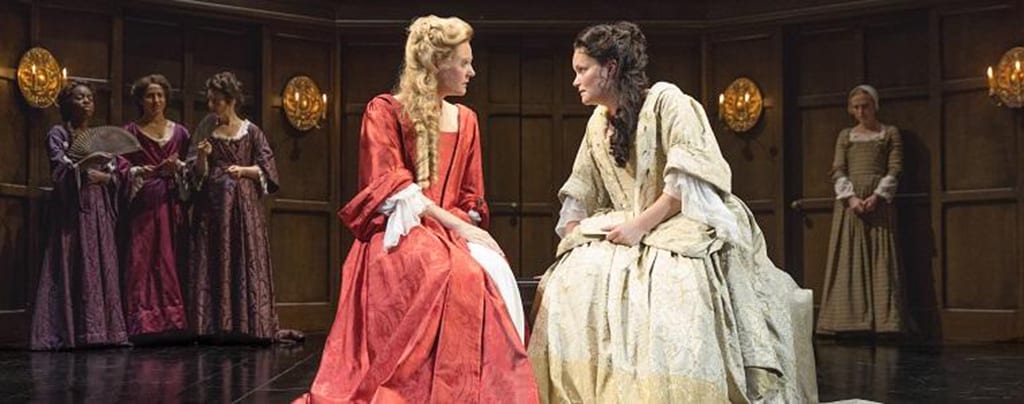Queen Anne, the last of the Stuarts, is one of the more elusive British monarchs. She reigned for 12 years, 1702-1714, but who is she?
Helen Edmundson’s brilliant script, Natalie Abrahami ‘s superb direction combined with Hannah Clark’s effective set design and lavish costume recreate a convincing personality that has largely been neglected.
Edmundson presents in the first two scenes an unflattering image of the woman to be crowned the Queen of England. This prelude is crucial to the understanding the stature of Anne the Queen
By the time she morphs from a princess to a queen, her body has been battered by seventeen pregnancies, of which twelve are miscarriages or stillbirths and brought forth only five live-born children, none of whom survive beyond the age of 11. This is a crushing tragedy for any woman, but Princess Anne, who at the age of 12 had survived smallpox and struggles with other ailments, drew strength from God and a strong sense of mission.
A parody in the opening scene, set in the Inns of Court, London, where, the likes of Daniel Defoe, Jonathan Swift, Dr John Radcliffe and Robert Harley lampoon with song and dance, the Princess ‘s numerous pregnancies, simulating copulation in a bawdy way evoking personal attack on the woman we are to meet in the next chamber scene. Here, a meek and needy Princess, utterly reliant on those around her emerges. The unflattering image that Edmundson’s play superbly delineates, draws the audience in.
Clark’s period costume including the wigs, sustain the distance between the heroine and the audience. The fat unimpressive princess with swollen legs can easily translate into a metaphor of her standing in the Royal Court of her much detested and hated, her brother-in-law, the king, William of Orange.
At the heart of the first part of the play is Anne’s passionate attachment to Sarah Churchill (yes, Winston Churchill’s ancestor) whom she unashamedly loves. ‘You know you have my heart’ she desperately tells Sarah. That love, Edmundson implies, lies largely on Anne’s side, with the ambitious Sarah using it as an instrument of power, only to find herself supplanted by Abigail Hill (Beth Park), a sharp, loyal and feisty maid and Robert Harley (James Garnon), a politically astute and mildly humorous Speaker of the Commons, appointed Lord Chancellor. Behind the scenes, he guides her through the political dynamics: Tories versus Whigs representing peace versus war. Intrigues and machinations are hatched and the playwright exposes political and personal intrigues. Queen Anne, like a queen in a good chess game, calculates the requisite moves that help her maintain her crown until her death.
Emma Cunniffe, in the title role, splendidly conveys the gradual transformation that Princess Anne undergoes once the weight of the crown sits firmly on her head. She graduates from a crippled woman dressed in a grubby black, tent-like garb to an upright well-groomed, rather dignified and regal in a flattering cream-coloured outfit with the hint of gold and white fur.
Romola Garai’s Sarah Churchill, later the Duchess of Marlborough, perfectly contrasts with Cunniffe’s Queen Anne. Garai cuts an attractive and confident Churchill, who manages to slither between concern for the well being of the Princess to total control and manipulation under the guise of loving-kindness. The two women’s friendship and Anne’s infatuation with Sarah is plain to see.
Her powerful position and standing in the Royal Court is clear from the first scene. The men who have parodied the princess are dumbstruck when Abigail Hill mentions that she is related to the monarch on her mother’s side. Attitudes towards Hill change at once; respect and awe replace scorn and contempt. Eventually Sarah Churchill is blinded by her own self-esteem and Queen Anne’s gradual sobering.
Throughout the play, Anne grows in stature while Sarah Churchill diminishes hers through conceit and total immersion in her sense of power over the queen. Garai’s delivers the final lines with the delusional passion that leaves the 21st century audience smiling.





